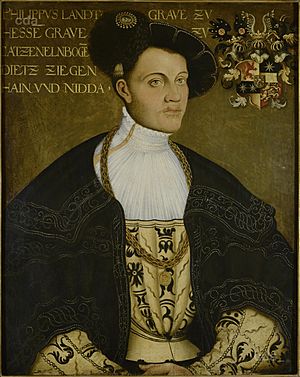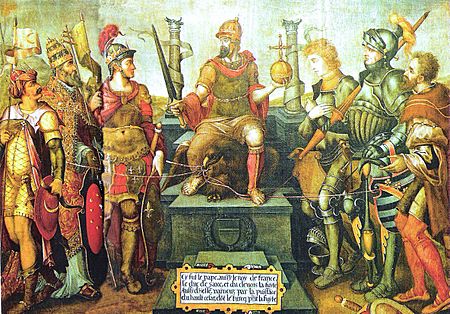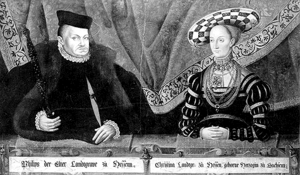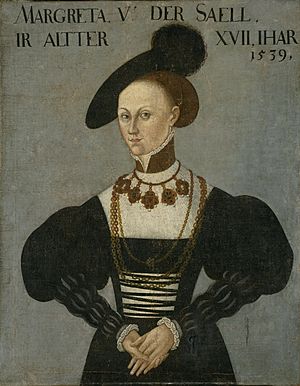Philip I, Landgrave of Hesse facts for kids
Quick facts for kids Philip I |
|
|---|---|

Portrait by Hans Krell, 1534
|
|
| Landgrave of Hesse | |
| Reign | 11 July 1509 – 31 March 1567 |
| Predecessor | William II |
| Successor | William IV (Hesse-Kassel) Louis IV (Hesse-Marburg) Philip II (Hesse-Rheinfels) George I (Hesse-Darmstadt) |
| Born | 13 November 1504 Marburg, Landgraviate of Hesse, Holy Roman Empire |
| Died | 31 March 1567 (aged 62) Kassel, Landgraviate of Hesse, Holy Roman Empire |
| Spouse |
|
| Issue |
|
| House | House of Hesse |
| Father | William II, Landgrave of Hesse |
| Mother | Anna of Mecklenburg-Schwerin |
| Religion | Lutheran (since 1524) Roman Catholic (until 1524) |
| Signature |  |
Philip I, Landgrave of Hesse (born November 13, 1504 – died March 31, 1567) was a powerful German ruler. He was known as "the Magnanimous" (meaning generous or forgiving). Philip was a key supporter of the Protestant Reformation, a major religious movement in Europe. He became one of the most important early Protestant leaders in Germany.
Contents
- Philip's Early Life and Becoming Protestant
- Bringing the Reformation to Hesse
- Philip's Religious Views and Alliances
- Leading the Schmalkaldic League
- Philip's Second Marriage and Its Impact
- Working with the Emperor
- Renewed Conflict with Charles V
- Philip's Imprisonment and Release
- Philip's Later Years
- Philip's Marriages and Children
- Images for kids
- See also
Philip's Early Life and Becoming Protestant
Philip was born in 1504. His father, William II, Landgrave of Hesse, died when Philip was only five years old. His mother, Anna of Mecklenburg-Schwerin, became his regent (a temporary ruler). She struggled to keep control of the region of Hesse.
To end these struggles, Philip was declared old enough to rule in 1518. He officially took power the next year. Even though his education was not perfect, he quickly became a skilled leader. He worked to increase his power as a ruler.
Philip Meets Martin Luther
In 1521, at age 17, Philip met Martin Luther at the Diet of Worms. This was a big meeting where Luther defended his new religious ideas. Philip was impressed by Luther, even though he wasn't very interested in religion at first.
Philip became a Protestant in 1524 after meeting Philipp Melanchthon, another important religious thinker. He then helped stop the German Peasants' War. He defeated the rebel leader Thomas Müntzer at the Battle of Frankenhausen.
Philip refused to join a group against Luther in 1525. He formed an alliance with John, Elector of Saxony in 1526. This showed he was already trying to create a group to protect Protestant rulers. He also wanted to prevent the Catholic Archduke Ferdinand from becoming the Holy Roman Emperor. At the First Diet of Speyer in 1526, Philip openly supported the Protestant cause. He allowed Protestant preachers to share their ideas.
Bringing the Reformation to Hesse
Even though most people in Hesse weren't strongly pushing for Protestantism, Philip decided to change the church there. He wanted it to follow Protestant rules. He was helped by his chancellor, Johann Feige, and his chaplain, Adam Krafft. He also got help from François Lambert, a former monk.
Philip closed monasteries and religious buildings. He used their money for charity and schools. In 1527, he founded the University of Marburg. It was meant to train Protestant religious leaders, like the University of Wittenberg.
Standing Up to Catholic Rulers
Some Catholic leaders, like Philip's father-in-law George, Duke of Saxony, were against the Reformation. They tried to stop its growth. Philip heard rumors of a secret group of Catholic princes planning to attack Protestants. An adventurer named Otto von Pack gave him a fake document that seemed to confirm these fears.
Philip met with Elector John of Saxony in 1528. They agreed that Protestant princes should prepare to defend themselves. However, Luther and others advised against attacking first. The imperial government then ordered everyone to keep the peace. Philip managed to get money from Catholic areas to cover his defense costs.
Despite these challenges, Philip remained active. At the Second Diet of Speyer in 1529, he was ignored by Emperor Charles V. But Philip played a big part in uniting Protestant representatives. He also helped create the famous Protestation at Speyer, a protest against the Emperor's decisions. Before leaving Speyer, he secretly formed an agreement with Saxony, Hesse, Nuremberg, Strasburg, and Ulm.
Philip's Religious Views and Alliances
Philip wanted to prevent arguments among Protestants about the Eucharist (Communion). He invited Huldrych Zwingli, a Swiss reformer, to Germany. This led to the Marburg Colloquy, a meeting to discuss religious differences. Even though the meeting didn't fully unite everyone, Philip believed that differences between Luther's and Zwingli's followers were honest disagreements. He thought Holy Scripture couldn't fully settle them.
Because of this, some people thought Philip leaned towards Zwingli's ideas. His support for Zwingli and Martin Bucer (a reformer from Strasburg) grew. This was especially true after the Emperor got angry about a Protestant statement Philip sent. Philip also wanted a big Protestant alliance to stop the Holy Roman Emperor. This made some of Luther's followers wary of him at the Diet of Augsburg in 1530. Philip had to explain that he agreed with Lutherans on the Eucharist but didn't think the Swiss should be persecuted.
When Emperor Charles V arrived, he demanded that Protestants join Catholic processions and stop Protestant preaching. Philip refused. He tried to change parts of the Augsburg Confession (a key Protestant statement). When his ideas were rejected, Philip left the Diet. He told his representatives to keep fighting for the Protestant cause. He even offered Luther a safe place in Hesse. Philip also became close with Martin Bucer, who agreed with him on finding compromises.
Leading the Schmalkaldic League
Philip believed that rulers had the right to choose the religion of their land. This idea, "cuius regio, eius religio" (whose realm, his religion), gave him power. He used this power to gather support for a defensive alliance. This led to the creation of the Schmalkaldic League.
In 1531, Philip successfully brought Protestant powers together to form the Schmalkaldic League. This group aimed to protect their religious and political interests from the Emperor. Philip and his ally, John, Elector of Saxony, became the main leaders. Philip was sure that the Protestant cause depended on weakening the power of the Habsburg emperors.
Philip first tried to achieve his goals peacefully. He suggested a compromise about church property that had been taken. But he also prepared for war and made alliances with anyone who opposed the Habsburgs. A peaceful agreement was reached with the Emperor in 1532. However, Philip continued to prepare for future conflicts.
Philip worked hard to bring new allies into the league against Charles V and Archduke Ferdinand I of Austria. Ferdinand had taken control of the Duchy of Württemberg. In 1534, Philip won the Battle of Lauffen, taking Württemberg back from Ferdinand. This victory made Philip a hero in Protestant Germany and was seen as a win for the Schmalkaldic League. This war was very expensive for Philip.
The Schmalkaldic League grew stronger and became important in European politics. Both France and England sought its alliance. The league was extended for ten years in 1535. Its main goal was defense: "to provide defense and repulsion [of attack] and to keep ourselves and our subjects and related persons free of unjust violence."
However, disagreements among Protestant groups hurt their shared goals. Bucer, encouraged by Philip, tried to unite Protestants on a common religious platform. This led to the Wittenberg Concord. The Emperor's fears about the league's political aims were eased for a time. But the Protestants rejected a council that would include the Pope. They also took steps to make sure Protestantism would last. By 1538–39, tensions between Catholics and Protestants were very high. War was avoided only by a temporary agreement called the Frankfort Respite.
Philip's Second Marriage and Its Impact
Philip was married to Christine of Saxony and had many children with her. However, he decided to take a second wife, Margarethe von der Saale. This was a very unusual and controversial decision at the time. Philip sought advice from religious leaders like Luther and Melanchthon. They were hesitant but eventually gave a "secret advice" allowing it, seeing it as a difficult personal matter for Philip.
Philip married Margarethe in secret on March 4, 1540. This was a bad time for a scandal among Protestants, as the Emperor was about to invade Germany. A few weeks later, Philip's sister, Elisabeth, revealed the marriage. This caused a huge scandal across Germany. Some of Philip's allies refused to work with him. Luther, saying it was private advice, refused to admit his part in it.
Working with the Emperor
This event greatly affected the political situation in Germany. Philip had been planning to reform the Church and unite all opponents of the Habsburg family. But now, he decided to make peace with the Emperor. He offered to stay neutral in some imperial matters. In return, he asked for a pardon for his past opposition, without directly mentioning his second marriage.
The Emperor welcomed Philip's offers. Philip then worked to establish religious peace between Catholics and Protestants. He agreed to attend the Diet of Regensburg in 1541. His presence helped guide the religious discussions there. Philip also got the Emperor's permission to establish a university in Marburg. In exchange for a pardon, Philip agreed to support Charles V against all his enemies, except Protestantism and the Schmalkaldic League. He also promised not to make alliances with France, England, or the Duke of Cleves.
These special terms weakened Philip's position as the leader of the Protestant group. He became suspected by others. Although the league continued, its real power decreased. Many Protestant princes would not join the Schmalkaldic League.
In 1543, disagreements within the Protestant league forced Philip to step down from its leadership. He began to trust the Emperor more. At the Diet of Speyer in 1544, he strongly supported the Emperor's policies. The Emperor even planned to make him commander-in-chief in a war against the Turks.
Renewed Conflict with Charles V
The situation changed suddenly with the Treaty of Crépy in 1544. This treaty made Philip realize the danger facing Protestantism. He stopped the Catholic Duke Henry V from taking his lands by force. He also tried to form a new alliance of German princes against Austria. This alliance would prevent them from accepting the decisions of the planned Council of Trent.
However, these plans failed because of rivalry between Duke Maurice of Saxony and Elector John Frederick I of Saxony. The Emperor, worried by Philip's plans, invited him to a meeting. Philip openly criticized the Emperor's policies. It became clear that peace could not last. Four months later, on July 20, 1546, the Emperor declared John Frederick and Philip to be rebels and traitors. This led to the Schmalkaldic War. The Protestants lost the war. The defeat at the Battle of Mühlberg in 1547 and the capture of Elector John Frederick marked the end of the Schmalkaldic League.
Philip, who had been negotiating with the Emperor, agreed to surrender. He was promised that his lands would not be harmed and that he would not be imprisoned. However, these promises were broken. On June 23, 1547, both Philip and John Frederick were taken captive to southern Germany.
Philip's Imprisonment and Release

Philip's imprisonment caused great difficulties for Protestants in Hesse. The church there had been well-organized by Philip. But now, public worship lacked order, and many different religious groups appeared. The Augsburg Interim, a temporary law, was introduced. It allowed some Catholic practices.
Philip himself wrote from prison, urging people to accept the Augsburg Interim. He believed his freedom depended on it. He thought that as long as Protestant ideas like justification by faith were allowed, other matters were less important. He even read Catholic books and attended mass. However, the clergy in Hesse strongly opposed the Interim. The government in Kassel refused to obey Philip's commands. His imprisonment became harder when he learned about the problems in Hesse. His confinement became stricter after he tried to escape.
Finally, in 1552, the Peace of Passau gave him his freedom. On September 12, 1552, he returned to his capital, Kassel.
Philip's Later Years
After his release, Philip worked to restore order in his lands. But new leaders, like Maurice of Saxony, had emerged. Philip no longer wanted to lead the Protestant movement. Instead, he focused on finding ways for Protestants and Catholics to agree. He directed his religious experts to attend meetings where they tried to find common ground.
Philip was also worried about conflicts among Luther's followers after Luther's death. He always stressed the need for different Protestant groups, like Calvinists and Lutherans, to tolerate each other. He hoped for a large Protestant alliance. To achieve this, he built friendly relationships with French Protestants and Elizabeth I of England.
He gave money to the Huguenots, and Hessian troops fought alongside them in the French religious wars. This policy helped lead to a declaration of religious tolerance in Amboise in 1563. Philip shaped the Hessian Church with his plans in 1566–67. In his will, written in 1562, he urged his sons to uphold the Augsburg Confession and the Wittenberg Concord. He also told them to work towards reuniting Catholics and Protestants if possible.
Philip died in 1567 and was buried in Kassel.
Philip's Marriages and Children
Philip married Christine of Saxony in Dresden on December 11, 1523. They had 10 children:
- Agnes (1527–1555)
- Anna (1529–1591)
- William IV of Hesse-Kassel (1532–1592)
- Philip Louis (1534–1535)
- Barbara (1536–1597)
- Louis IV of Hesse-Marburg (1537–1604)
- Elisabeth (1539–1582)
- Philip II of Hesse-Rheinfels (1541–1583)
- Christine (1543–1604)
- George I of Hesse-Darmstadt (1547–1596)
On March 4, 1540, Philip also married Margarethe von der Saale. This was a second marriage while still married to Christine. With Margarethe, he had the following children:
- Philipp, Count zu Dietz (1541–1569)
- Hermann, Count zu Dietz (1542–c. 1568)
- Christopher Ernst, Count zu Dietz (1543–1603)
- Margretha, Countess zu Dietz (1544–1608)
- Albrecht, Count zu Dietz (1546–1569)
- Philipp Konrad, Count zu Dietz (1547–1569)
- Moritz, Count zu Dietz (1553–1575)
- Ernst, Count zu Dietz (1554–1570)
- Anna, Countess zu Dietz (1557–1558)
After Philip's death, his lands were divided among his four sons from his first marriage. These lands became Hesse-Kassel, Hesse-Marburg, Hesse-Rheinfels, and Hesse-Darmstadt.
Images for kids
See also
 In Spanish: Felipe I de Hesse para niños
In Spanish: Felipe I de Hesse para niños




